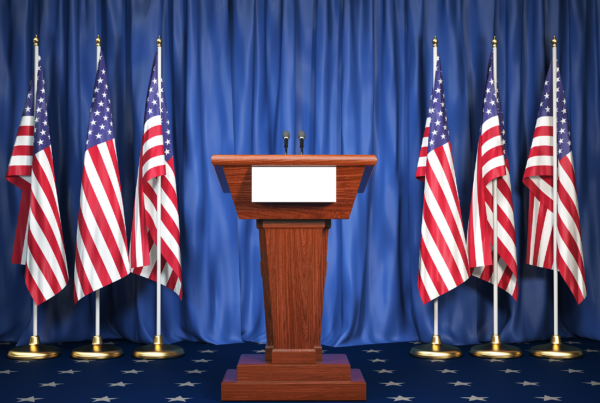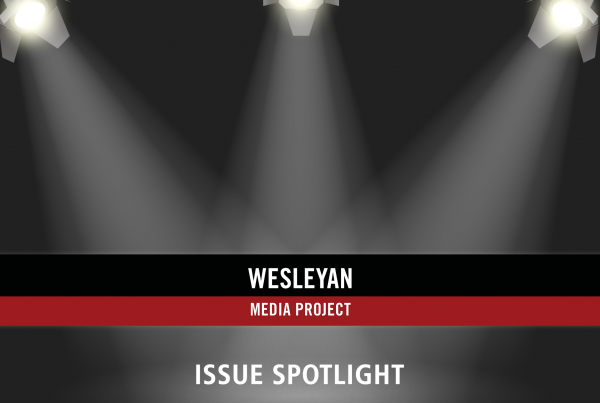Outside groups, mostly dark money,
account for 1 in every 3 ads in House and Senate races
![]()
May 7, 2018
![]()
Report Highlights
• 2014 vs. 2018 midterm ad airing comparisons (Table 1)
• Ad volumes/spending in statewide races with primaries May 8, 15, and 22 (Table 2 and Table 3)
• Gov races see the most advertising with over 350,000 airings to date (Table 4)
• House special elections in MT-1, GA-6, PA-18, SC-5 top the list with most ad airings (Table 5)
• Conservative-leaning outside groups are very active (Table 6)
• Dark money accounts for 3 in 5 outside group ads in Congressional races (Jump to text)
• Republican ads focused largely on support for Trump; attacks against Obama/Clinton (Table 8)
• Dems mention more traditional policy issues in ads—healthcare, the economy, Social Security (Table 8)
![]()
(MIDDLETOWN, CT) May 7, 2018 – Nearly 739,000 ads at an estimated cost of over $260 million have aired to date in races for House, Senate, and governor between January 1, 2017 and May 3, 2018. This represents an 88.6 percent increase in ad airings over the comparable period in 2014, through May 3, which only saw roughly 392,000 airings. Table 1 shows the breakdowns by race and sponsor.
![]()
Table 1: Cycle-to-Date Midterm Comparison, 2014 vs. 2018
| Candidate | Party | Group | Coordinated | Total | % increase | ||
|---|---|---|---|---|---|---|---|
| 2014 | House | 40,308 | 5,254 | 24,056 | 396 | 70,014 | |
| Senate | 65,663 | 402 | 80,922 | 929 | 147,916 | ||
| Governor | 113,505 | 4,791 | 49,603 | 5,984 | 173,883 | ||
| Total | 391,813 | ||||||
| 2018 | House | 113,817 | 12,179 | 54,984 | 820 | 181,800 | 159.7% |
| Senate | 116,464 | 7 | 88,805 | 1,344 | 206,620 | 39.7% | |
| Governor | 298,179 | 2,984 | 49,312 | 0 | 350,475 | 101.6% | |
| Total | 738,895 | 88.6% | |||||
| Figures are from January 1, 2013 to May 3, 2014 and January 1, 2017 to May 3, 2018. Numbers include broadcast television. CITE SOURCE OF DATA AS: Kantar Media/CMAG with analysis by the Wesleyan Media Project. |
|||||||
The increase is driven by several factors. First, there have been unusually heated and costly special elections, the consequence of a heavy national focus in these races. In special election House races in Montana (at-large), Georgia (6th), and Pennsylvania (18th), there were nearly 90,000 ads aired, costing over $40 million. Another 60,000 ads costing over $14 million aired in the Alabama special election for Jeff Sessions’ old Senate seat.
The other factors include outside group targeting of vulnerable incumbents on health care and tax reform votes – in House races, for example, over 54,000 ads have aired from outside groups, which is more than double the total from House races in 2014 – and the presence of heavily contested party primaries in many states. The high volume of gubernatorial airings in Illinois and Virginia are also contributing to the increase.
![]()
“The 2016 presidential election saw a drop in TV ad volume that was not paralleled in other federal races, and we noted then that time would tell whether the 2016 election represented a turning point in campaign strategy,” said Erika Franklin Fowler, co-director of the Wesleyan Media Project. “So far, the 2018 cycle suggests that TV advertising is alive and well as a campaign tactic, as special elections, hotly contested primaries and outside groups targeting vulnerable incumbents have driven TV ad totals well above the 2014 benchmark for this same time period.”
![]()
A large number of states hold primary races in May, and the volume of advertising in those races is ramping up. One hot spot is the race for the Republican nomination for Senate in Indiana, where three candidates (Luke Messer, Todd Rokita and Mike Braun) have combined to air almost 21,000 ads. Another 8,200 ads have aired by interest groups involved in that race. The winner of that May 8 primary will take on Senator Joe Donnelly in the general election.
Table 2 shows ad volumes in statewide races in the upcoming May 8 primaries. In addition to Indiana, the fight for the GOP nomination in Ohio’s gubernatorial race is vigorous. Over 15,000 ads have aired by Republican candidates Mike DeWine (almost 12,000 ads; he is also a former Senator from the state) and Mary Taylor (3,600 ads; she is the current Lieutenant Governor). Polls show DeWine with a heavy lead but a sizeable number of respondents are still undecided.
The GOP nomination race in West Virginia is also drawing a lot of advertising, with nearly 19,000 ads through May 3rd. The leading contenders, Even Jenkins (a current Congressman from the state’s 3rd congressional district) and Patrick Morrisey (the state’s Attorney General), have been out-advertised by Don Blankenship, former Chairman and CEO of Massey Energy, who has aired over 10,000 ads.
![]()
Table 2: Ad Volumes and Spending in Statewide Races with May 8 Primaries
| State | Race | # Ads | Est. Cost (in Ms) | Dem Cand Ads | GOP Cand Ads | Dem Group Ads | GOP Group Ads |
|---|---|---|---|---|---|---|---|
| Indiana | Senate | 34,779 | 8.8 | 1,376 | 20,913 | 4,283 | 8,200 |
| Ohio | Governor | 20,052 | 6.8 | 2,717 | 15,655 | 0 | 1,672 |
| Ohio | Senate | 1,160 | 0.36 | 0 | 990 | 0 | 164 |
| West Virginia | Senate | 27,598 | 4.6 | 726 | 18,724 | 4,946 | 3,126 |
| Figures are from January 1, 2017 to May 3, 2018. Numbers include broadcast television. CITE SOURCE OF DATA AS: Kantar Media/CMAG with analysis by the Wesleyan Media Project. |
|||||||
A number of states hold primaries on May 15 and May 22. Here, too, the nomination campaigns in GOP races have been hotly contested. Table 3 shows ad volumes in these statewide races. In Idaho, three candidates are vying for the gubernatorial nomination, including a current congressman and the state’s Lieutenant Governor, both of whom are airing ads. Two outside groups, Idaho First PAC (promoting businessman Tommy Ahlquist) and Protect Freedom PAC (supporting Congressman Raul Labrador’s bid for the nomination), are also on television. The little polling done in the race shows a tight contest.
In Pennsylvania, two Republicans have invested heavily in their bid to face off against the incumbent, Democrat Tom Wolf. Current state senator Scott Wagner has aired nearly 7,800 ads while businessman Paul Mango has aired just under 5,000 ads. Polls show Wagner with the lead, but some polls show a sizeable number of undecided voters.
In Georgia, both parties have nomination races. On the Democratic side, two former state representatives, Stacey Evans and Stacey Abrams, are on the ballot. Evans has aired over 4,000 ads to Abrams’ 450, but Abrams is backed by Black PAC and PowerPAC Georgia, which have combined to air 1,000 ads promoting her campaign. On the GOP side, current Lieutenant Governor Casey Cagle is running against Brian Kemp, the secretary of state, and Hunter Hill, a former state senator. Cagle has aired nearly 5,000 ads, more than twice as many as Hunter. He is also supported by the one group active in the GOP race, Citizens for Georgia’s Future.
![]()
Table 3: Ad Volumes and Spending in States with May 15 and May 22 Primaries
| State | Race | # Ads | Est. Cost | Dem Cand Ads | GOP Cand Ads | Dem Group Ads | GOP Group Ads |
|---|---|---|---|---|---|---|---|
| Idaho | Governor | 21,801 | 2.3 M | 5,863 | 13,527 | 0 | 2,411 |
| Nebraska | Governor | 1,325 | 65 K | 0 | 1,325 | 0 | 0 |
| Nebraska | Senate | 18 | 1.3 K | 0 | 18 | 0 | 0 |
| Oregon | Governor | 2,593 | 533 K | 0 | 2,498 | 0 | 95 |
| Penn. | Governor | 16,185 | 6.2 M | 1,838 | 12,688 | 1,659 | 0 |
| Penn. | Senate | 175 | 83 K | 0 | 0 | 0 | 175 |
| Arkansas* | Governor | 344 | 99 K | 0 | 260 | 0 | 80 |
| Georgia* | Governor | 15,095 | 4.3 M | 4,585 | 7,527 | 1,091 | 1,892 |
| Figures are from January 1, 2017 to May 3, 2018. Numbers include broadcast television. CITE SOURCE OF DATA AS: Kantar Media/CMAG with analysis by the Wesleyan Media Project. *May 22 (all else are May 15). |
|||||||
Gubernatorial Advertising Dominates 2018 Cycle-to-Date Figures
Looking at cycle-to-date advertising – from January 1, 2017, through May 3, 2018 – gubernatorial airings dominate with over 350,000 airings to date. A large number of these aired in the Illinois gubernatorial primaries (which saw over 90,000 airings in the March 20 primary) and the 2017 Virginia gubernatorial election, which had nearly 88,000 airings in total. The bulk of advertising in gubernatorial races has come from candidates, with just over 14 percent of airings from outside groups.
Senate contests have seen over 206,000 airings so far, while advertising for House races is not far behind at nearly 182,000 airings. As shown in Table 4, outside groups have been particularly active in early Senate contests, collectively accounting for roughly 43 percent of all television airings to date, and in congressional races where overall they have aired roughly a third of all ads to date (32.3 percent).
![]()
Table 4: Ad Volumes and Spending in Federal and Gubernatorial Races (Cycle to Date)
| # Ads | Est. Cost (in Ms) | Dem Cand Ads | GOP Cand Ads | Dem Group Ads | GOP Group Ads | |
|---|---|---|---|---|---|---|
| Governor | 350,475 | 139.4 | 148,284 | 149,877 | 20,464 | 28,848 |
| Senate | 206,620 | 53.7 | 46,037 | 70,207 | 39,410 | 48,414 |
| House | 181,853 | 68.8 | 68,072 | 45,630 | 18,934 | 35,192 |
| Figures are from January 1, 2017 to May 3, 2018. Numbers include broadcast television. CITE SOURCE OF DATA AS: Kantar Media/CMAG with analysis by the Wesleyan Media Project. |
||||||
Special Elections for U.S. House Seats Dominate Airings
Table 5 shows the top House races measured by advertising volume since January 1, 2017 along with the proportions of advertising coming from outside groups, many of which have focused on the legislative actions of vulnerable representatives. As shown below, the 2017 special elections in Montana (an astounding 48,771 airings), Georgia (32,686 airings), Pennsylvania (8,733) and South Carolina (5,263) top the list.
California’s 49th and 21st districts have also seen thousands of airings to date, many of them from outside groups – like Save My Care or American Action Network – attacking or bolstering (respectively) Republican attempts at health care reform and the tax bill.
Iowa’s 1st congressional district has seen over 4,000 airings to date, the bulk of which have come from outside groups Not One Penny and American Network, which attacked (in the case of Not One Penny) and praised (American Action Network) Rod Blum for his legislative action on health care and tax reform. Texas’ 16th district has seen just over 3,400 airings, the bulk of which have come from primary contenders.
The other top House races where advertising has come solely from outside groups so far – New York’s 24, Arizona and Maine’s second districts – have all featured advertising focused on the incumbent representatives’ positions on key legislation.
![]()
Table 5: Top House Races with Over 1,500 Airings, Cycle to Date (Jan 1, 2017 – May 3, 2018)
| Race | Airings | Cost (in Ms) | % Group |
|---|---|---|---|
| MT-1 | 48,771 | 4.32 | 10.8% |
| GA-6 | 32,686 | 28.57 | 15.9% |
| PA-18 | 8,733 | 8.41 | 33.2% |
| SC-5 | 5,263 | 1.73 | 33.0% |
| CA-49 | 5,155 | 1.76 | 35.9% |
| CA-21 | 4,191 | 0.67 | 100% |
| IA-1 | 4,057 | 0.86 | 92.3% |
| TX-16 | 3,417 | 0.72 | 22.1% |
| KY-6 | 2,613 | 0.61 | 0% |
| AZ-8 | 2,568 | 1.55 | 2.5% |
| NE-2 | 2,263 | 0.71 | 76.4% |
| UT-3 | 2,248 | 0.64 | 31.0% |
| NY-24 | 2,243 | 0.45 | 100% |
| AZ-2 | 2,231 | 0.39 | 100% |
| TX-23 | 2,108 | 0.88 | 28.2% |
| WV-3 | 2,096 | 0.31 | 8.2% |
| OH-12 | 1,967 | 0.48 | 30.5% |
| KS-4 | 1,966 | 0.39 | 0% |
| IL-13 | 1,933 | 0.24 | 11.2% |
| PA-13 | 1,715 | 0.26 | 0% |
| ME-2 | 1,702 | 0.26 | 100% |
| IL-3 | 1,614 | 1.02 | 24.8% |
| IN-4 | 1,571 | 0.48 | 5.2% |
| IA-3 | 1,510 | 0.54 | 74.6% |
| Figures are from January 1, 2017 to May 3, 2018. Numbers include broadcast television. CITE SOURCE OF DATA AS: Kantar Media/CMAG with analysis by the Wesleyan Media Project. |
|||
Republican Groups Very Active
Four of the top five most active outside groups on television this cycle are advertisers supporting Republicans. American Action Network and Americans for Prosperity, two conservative-leaning groups, are leading the list of outside groups airing ads in key contests across the country. While American Action Network has aired more than 16,000 ads in more than 30 congressional contests so far – primarily thanking Republicans for action on health care and tax reform – Americans for Prosperity has focused its more than 15,000 airings primarily on U.S. Senate and gubernatorial contests in Wisconsin, Indiana, Virginia, Montana, Missouri and North Dakota.
Senate Majority PAC, the sole Democratic organization in the top five, ranks third with nearly 10,000 airings to date on behalf of Democratic senatorial candidates in Indiana, Missouri, Montana, North Dakota, West Virginia and Wisconsin.
Two other pro-Democratic groups – Save My Care and Not One Penny – have been actively targeting vulnerable incumbent legislators for their positions on health care and tax reform in particular.
![]()
Table 6: Top Group Advertisers in Federal and Gubernatorial Races
| Sponsor | # Ads | Est. Cost (in Ms) | Party Lean | Races |
|---|---|---|---|---|
| American Action Network | 16,056 | 4.6 | Pro-GOP | House: CA10, CA21, CA25, CA49, CO-06, FL-18, FL-26, IA-01, IA-02, ID-01, IL-12, IL-13, IL-17, KS-03, ME-02, MN-01, MN-07, MN-08, NC-11, NE-02, NV-03, NY-21, NY-22, NY-23, NY-24, NY-27, OH-10, PA-16, PA-17, TX-23, VA-10, WI-01, WI-03 |
| Americans For Prosperity | 15,100 | 5.4 | Pro-GOP | Gov-VA, Gov-WI, Sen-IN, Sen-MO, Sen-MT, Sen-ND, Sen-VA, Sen-WI |
| Senate Majority PAC | 9,968 | 3.6 | Pro-Dem | Sen-IN, Sen-MO, Sen-MT, Sen-ND, Sen-WV, Sen-WI |
| Senate Leadership Fund | 9,903 | 2.5 | Pro-GOP | Sen-AL |
| Congressional Leadership Fund | 8,457 | 4.6 | Pro-GOP | House: GA-06, MT-01, PA-18 |
| Save My Care | 6,967 | 2.2 | Pro-Dem | Sen-AZ, Sen-NV, Gov-CT, House: AK-01, AZ-02, CA-21, CA-49, ME-02, NV-02, NJ-03, OH-01, OH-12, OH-16 |
| Majority Forward | 5,726 | 1.2 | Pro-Dem | Sen-AZ, Sen-IN, Sen-MT, Sen-ND, Sen-NV, Sen-WV |
| Restoration PAC | 5,579 | 1.9 | Pro-GOP | Sen-MT, Sen-WV, Sen-WI |
| State Solutions, Inc. | 4,823 | 3.7 | Pro-GOP | Gov-IL |
| All About Florida | 4,711 | 2.2 | Pro-Dem | Gov-FL |
| Concerned Veterans for America | 4,513 | 1.2 | Pro-GOP | Sen-WI |
| California Charter Schools Association Advocates | 4,422 | 4.7 | Pro-Dem | Gov-CA |
| Not One Penny | 4,391 | 1.4 | Pro-Dem | Sen-NV, Sen-ND, House: AR-01, AZ-02, CA-25, CO-06, IA-01, IA-03, IL-06, KS-03, ME-02, NE-02, NV-02, NY-24, OH-13, TX-23 |
| NRA Political Victory Fund | 4,387 | 1.9 | Pro-GOP | Gov-VA, Sen-AL, House: MT-01 |
| AARP | 4,209 | 1.6 | Pro-Dem/Other | Sen-AZ, Sen-NV, Sen-TN |
| Figures are from January 1, 2017 to May 3, 2018. Numbers include broadcast television. CITE SOURCE OF DATA AS: Kantar Media/CMAG with analysis by the Wesleyan Media Project. |
||||
Dark Money Accounts for Three in Every Five Outside Group Ads in Congressional Races
In partnership with the Center for Responsive Politics, the Wesleyan Media Project tracks the disclosure type of outside groups in federal races. We classify groups as full disclosure groups (meaning they disclose contributor lists to the Federal Election Commission), non-disclosure dark money groups (which are not required to disclose publicly their donors; these are most often 501c4 non-profits), and partial disclosure groups (those that disclose donors but also accept contributions from dark money sources).
Table 7 reports the volume and spending on advertising from these three group types in the current election cycle. In both House and Senate races, the majority of outside spending—and 2 in 3 group ads in Senate races—are from dark money groups that do not disclose. Only 30,000 group airings of the 150,000 aired thus far in congressional races are from groups that fully disclose their donors.
![]()
“It is not uncommon for outside group advertising early in a congressional cycle to be from dark money sources,” said Wesleyan Media Project co-director, Michael Franz. “Unless an ad explicitly tells you whom to vote for, federal reporting windows require only television ads aired within 30 days of a primary to be reported as electioneering spending. This allows some groups to advocate early for their preferred candidates but avoid reporting mandates.”
Table 7: Outside Group Donor Disclosure
| House | Airings | Est Cost (in Ms) | % of ads |
|---|---|---|---|
| Full | 6,671 | 3.2 | 12.13% |
| Partial | 11,081 | 5.5 | 20.15% |
| None | 37,232 | 12.8 | 67.71% |
Senate|
| | ||
| Full | 23,075 | 6.2 | 25.98% |
| Partial | 14,572 | 5.0 | 16.41% |
| None | 51,158 | 16.7 | 57.61% |
| Figures are from January 1, 2017 to May 3, 2018. Numbers include broadcast television. CITE SOURCE OF DATA AS: Kantar Media/CMAG with analysis by the Wesleyan Media Project. |
|||
Republican Candidates Happy to Mention Trump
Table 8 reveals some striking differences in the issues discussed by Democratic and Republican candidates running for congress in the May 8 primary races. While Democrats are primarily mentioning the policy issues that are mainstays of political campaigns—such as healthcare, the economy and Social Security—Republicans are talking more about particular politicians, expressing their support for Trump and attacking Obama and Clinton. Republicans are also mentioning many issues that divide the political parties—such as immigration, abortion, and guns—but like Democrats they are also talking about the economy.
![]()
“To have pro-Trump messages topping the list of mentions in Republican advertising is somewhat surprising,” said Travis Ridout, co-director of the Wesleyan Media Project. “In a midterm election year, when the president’s party typically loses seats, candidates generally want to downplay their connection to a sitting president, but it appears that many Republican candidates believe that associating themselves with Trump is key to securing their party’s nomination.”
![]()
Table 8: Top Issues Mentioned by Democrats and Republican in May 8 Primary Races
| Pro-Dem | Pro-Rep |
|---|---|
| Healthcare | Pro-Trump |
| Economy (Jobs/Budget/Taxes) | Immigration |
| Coal | Economy (Jobs/Taxes) |
| Social Security | Abortion |
| Veterans Issues | Anti-Obama |
| Campaign Finance | Anti-Clinton |
| Corruption | Guns |
| Figures are from January 1, 2018 to May 3, 2018. Races include US House and US Senate in states holding May 8 primaries (Indiana, North Carolina, Ohio, and West Virginia). CITE SOURCE OF DATA AS: Kantar Media/CMAG with analysis by the Wesleyan Media Project. |
|
![]()
![]()
About This Report
Data reported here from Kantar/CMAG do not cover local cable buys, only broadcast television, national network and national cable buys. All cost estimates are precisely that: estimates.
The Wesleyan Media Project (WMP) provides real-time tracking and analysis of all political television advertising in an effort to increase transparency in elections. Housed in Wesleyan’s Quantitative Analysis Center – part of the Allbritton Center for the Study of Public Life – the Wesleyan Media Project is the successor to the Wisconsin Advertising Project, which disbanded in 2009. It is directed by Erika Franklin Fowler, associate professor of government at Wesleyan University, Michael M. Franz, professor of government at Bowdoin College and Travis N. Ridout, professor of political science at Washington State University. WMP staff include Laura Baum (Project Manager), Dolly Haddad (Project Coordinator) and Matthew Motta (Research Associate).
The Wesleyan Media Project is supported by Wesleyan University. Data are provided by Kantar Media/CMAG with analysis by the Wesleyan Media Project. WMP is partnering again this year with the Center for Responsive Politics, to provide added information on outside group disclosure.
Periodic releases of data will be posted on the project’s website and dispersed via Twitter @wesmediaproject. To be added to our email update list, click here.
For more information contact:
Lauren Rubenstein, lrubenstein@wesleyan.edu, (860) 685-3813
About Wesleyan University
Wesleyan University, in Middletown, Conn., is known for the excellence of its academic and co-curricular programs. With more than 2,900 undergraduates and 200 graduate students, Wesleyan is dedicated to providing a liberal arts education characterized by boldness, rigor and practical idealism. For more, visit wesleyan.edu.




